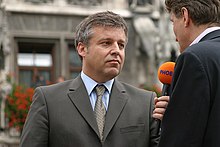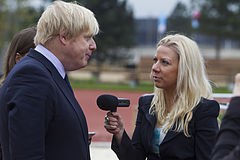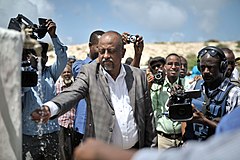Journalist
 | |
| Occupation | |
|---|---|
| Names | Journalist |
Occupation type | Journalism, mass media |
Activity sectors | Mass Media, public relations, politics, sports, business |
| Description | |
| Competencies | Writing skills, interpersonal skills |
Education required | Typically a bachelor's degree |
Fields of employment | Mass media |
Related jobs | Correspondent, columnist, spokesperson, politician |
A journalist is a person who gathers information in the form of text, audio or pictures, processes it into a newsworthy form and disseminates it to the public. This is called journalism.
Roles[edit]
Journalists can be broadcast, print, advertising or public relations personnel. Depending on the form of journalism, "journalist" may also describe various categories of people by the roles they play in the process. These includes reporters, correspondents, citizen journalist, editors, editorial writers, columnists and photojournalists.
A reporter is a type of journalist who researches, writes and reports on information in order to present using sources. This may entail conducting interviews, information-gathering and/or writing articles. Reporters may split their time between working in a newsroom, from home or outside to witness events or interviewing people. Reporters may be assigned a specific beat (area of coverage).
Matthew C. Nisbet, who has written on science communication,[1] has defined a "knowledge journalist" as a public intellectual who, like Walter Lippmann, Fareed Zakaria, Naomi Klein, Michael Pollan, and Andrew Revkin, sees their role as researching complicated issues of fact or science which most laymen would not have the time or access to information to research themselves, then communicating an accurate and understandable version to the public as a teacher and policy advisor.
In his best-known books, Public Opinion (1922) and The Phantom Public (1925), Lippmann argued that most people lacked the capacity, time and motivation to follow and analyze news of the many complex policy questions that troubled society. Nor did they often experience most social problems or directly access expert insights. These limitations were made worse by a news media that tended to oversimplify issues and to reinforce stereotypes, partisan viewpoints and prejudices. As a consequence, Lippmann believed that the public needed journalists like himself who could serve as expert analysts, guiding "citizens to a deeper understanding of what was really important".[2]
In 2018, the United States Department of Labor's Occupational Outlook Handbook reported that employment for the category "reporters, correspondents and broadcast news analysts" will decline 9 percent between 2016 and 2026.[3]
Modern overview[edit]
A worldwide sample of 27,500 journalists in 67 countries in 2012–2016 produced the following profile:[4]
- 57 percent male;
- mean age of 38
- mean years of experience, 13
- college degree, 56 percent; graduate degree, 29 percent
- 61 percent specialized in journalism/communications at college
- 62 percent identified as generalists and 23 percent as hard-news beat journalists
- 47 percent were members of a professional association
- 80 percent worked full-time
- 50 percent worked in print, 23 percent on television, 17 percent on radio and 16 percent online.
In 2019 the Reuters Institute for the Study of Journalism Digital News Report described the future for journalists in South Africa as “grim” because of low online revenue and plummeting advertising.[5]
In 2020 Reporters Without Borders secretary general Christophe Deloire said journalists in developing countries were suffering political interference because the COVID-19 pandemic had given governments around the world the chance “to take advantage of the fact that politics are on hold, the public is stunned and protests are out of the question, in order to impose measures that would be impossible in normal times”.[6]
In 2023 the closure of local newspapers in the US accelerated to an average of 2.5 per week, leaving more than 200 US counties as “news deserts” and meaning that more than half of all U.S. counties had limited access to reliable local news and information, according to researchers at the Medill School of Journalism, Media, Integrated Marketing Communications at Northwestern University.
In January 2024, The Los Angeles Times, Time magazine and National Geographic all conducted layoffs, and Condé Nast journalists went on strike over proposed job cuts.[7] The Los Angeles Times laid off more than 20% of the newsroom.[8] CNN, Sports Illustrated and NBC News shed employees in early 2024.[9] The New York Times reported that Americans were suffering from “news fatigue” due to coverage of major news stories like the Hamas attack, Russian invasion of Ukraine and the presidential election.[9] American consumers turned away from journalists at legacy organizations as social media became a common news source. [9]
Freedom[edit]
Journalists sometimes expose themselves to danger, particularly when reporting in areas of armed conflict or in states that do not respect the freedom of the press. Organizations such as the Committee to Protect Journalists and Reporters Without Borders publish reports on press freedom and advocate for journalistic freedom. As of November 2011, the Committee to Protect Journalists reports that 887 journalists have been killed worldwide since 1992 by murder (71%), crossfire or combat (17%), or on dangerous assignment (11%). The "ten deadliest countries" for journalists since 1992 have been Iraq (230 deaths), Philippines (109), Russia (77), Colombia (76), Mexico (69), Algeria (61), Pakistan (59), India (49), Somalia (45), Brazil (31) and Sri Lanka (30).[10]
The Committee to Protect Journalists also reports that as of 1 December 2010, 145 journalists were jailed worldwide for journalistic activities. Current numbers are even higher. The ten countries with the largest number of currently-imprisoned journalists are Turkey (95),[11] China (34), Iran (34), Eritrea (17), Burma (13), Uzbekistan (6), Vietnam (5), Cuba (4), Ethiopia (4) and Sudan (3).[12]
Apart from physical harm, journalists are harmed psychologically. This applies especially to war reporters, but their editorial offices at home often do not know how to deal appropriately with the reporters they expose to danger. Hence, a systematic and sustainable way of psychological support for traumatized journalists is strongly needed. Few and fragmented support programs exist so far.[13]
On 8 August 2023, Iran's Journalists' Day, Tehran Journalists' Association head Akbar Montajabi noted over 100 journalists arrested amid protests, while HamMihan newspaper exposed repression against 76 media workers since September 2022 following Mahsa Amini's death-triggered mass protests, leading to legal consequences for journalists including Niloufar Hamedi and Elaheh[14]
Relationship with sources[edit]
The relationship between a professional journalist and a source can be rather complex, and a source can sometimes have an effect on an article written by the journalist. The article 'A Compromised Fourth Estate' uses Herbert Gans' metaphor to capture their relationship. He uses a dance metaphor, "The Tango", to illustrate the co-operative nature of their interactions inasmuch as "It takes two to tango". Herbert suggests that the source often leads, but journalists commonly object to this notion for two reasons:
- It signals source supremacy in news making.
- It offends journalists' professional culture, which emphasizes independence and editorial autonomy.
The dance metaphor goes on to state:
A relationship with sources that is too cozy is potentially compromising of journalists' integrity and risks becoming collusive. Journalists have typically favored a more robust, conflict model, based on a crucial assumption that if the media are to function as watchdogs of powerful economic and political interests, journalists must establish their independence of sources or risk the fourth estate being driven by the fifth estate of public relations.[15]
Safety[edit]
Journalists can face violence and intimidation for exercising their fundamental right to freedom of expression. The range of threats they are confronted with include murder, kidnapping, hostage-taking, offline and online harassment, intimidation, enforced disappearances, arbitrary detention and torture. Women in journalism also face specific dangers and are especially vulnerable to sexual assault, whether in the form of a targeted sexual violation, often in reprisal for their work. Mob-related sexual violence aimed against journalists covering public events; or the sexual abuse of journalists in detention or captivity. Many of these crimes are not reported as a result of powerful cultural and professional stigmas.[16][17]
Increasingly, journalists (particularly women) are abused and harassed online, via hate speech, cyber-bullying, cyber-stalking, doxing, trolling, public shaming, intimidation and threats.[17]
Most dangerous year[edit]

According to Reporters Without Borders' 2018 annual report, it was the worst year on record for deadly violence and abuse toward journalists; there was a 15 percent increase in such killings since 2017, with 80 killed, 348 imprisoned and 60 held hostage.[18][19]
Yaser Murtaja was shot by an Israeli army sniper. Rubén Pat was gunned down outside a beach bar in Mexico. Mexico was described by Reporters Without Borders as "one of world's deadliest countries for the media"; 90% of attacks on journalists in the country reportedly go unsolved.[20] Bulgarian Victoria Marinova was beaten, raped and strangled. Saudi Arabian dissident Jamal Khashoggi was killed inside Saudi Arabia's consulate in Istanbul.[21]
Commemoration[edit]
From 2008 to 2019, Freedom Forum's now-defunct Newseum in Washington, D.C. featured a Journalists Memorial which honored several thousand journalists around the world who had died or were killed while reporting the news.[22] After the Newseum closed in December 2019, supporters of freedom of the press persuaded the United States Congress in December 2020 to authorize the construction of a memorial to fallen journalists on public land with private funds.[22] By May 2023, the Fallen Journalists Memorial Foundation had begun the design of the memorial.[23]
Education[edit]
In the US, nearly all journalists have attended university, but only about half majored in journalism.[24][25] Journalists who work in television or for newspapers are more likely to have studied journalism in college than journalists working for the wire services, in radio, or for news magazines.[25]
Gallery[edit]
-
A program director sets the task for TV journalists, 1998.
-
A reporter interviews a man in Helmand Province, Afghanistan, 2009.
-
Journalist interviews a cosplayer, 2012.
-
A reporter interviewing Boris Johnson when he was Mayor of London, 2014
-
Official tastes the water of a new well in front of journalists in Mogadishu, Somalia, 2014.
-
Cameraman and journalist who interviews a person in Austria
See also[edit]
References[edit]
- ^ Nisbet, Matthew C. (March–April 2009). "Communicating Climate Change: Why Frames Matter for Public Engagement". Environment Magazine. Heldref Publications. Taylor & Francis Group. Archived from the original on 3 July 2018. Retrieved 9 March 2019.
- ^ Nisbet, Matthew C. (March 2013). "Nature's Prophet: Bill McKibben as Journalist, Public Intellectual and Activist" (PDF). Discussion Paper Series #D-78. Joan Shorenstein Center on the Press, Politics and Public Policy, School of Communication and the Center for Social Media American University. p. 7. Retrieved 8 March 2013.
- ^ Talton, Jon (31 January 2018). "Occupational outlook: Where the big bucks are – and aren't". The Seattle Times. Retrieved 1 February 2018.
- ^ Thomas Hanitzsch, et al. eds. Worlds of Journalism: Journalistic Cultures around the Globe (2019) pp. 73–74. see excerpt
- ^ "Reuters Institute Digital News Report 2019" (PDF). Reuters Institute for the Study of Journalism. Thomson Reuters.
- ^ Ahmed, Kaamil (6 May 2020). "Covid-19 could trigger 'media extinction event' in developing countries". The Guardian.
- ^ Fu, Angela (24 January 2024). "Tuesday was a bleak day for the media industry". Poynter.
- ^ James, Meg (23 January 2024). "L.A. Times to lay off at least 115 people in the newsroom". L.A. Times.
- ^ a b c Robertson, Katie (24 January 2024). "The News About the News Business Is Getting Grimmer". New York Times.
- ^ "1337 Journalists Killed". Committee to Protect Journalists. Retrieved 28 August 2012.
- ^ "Number of Jailed Journalists Nearly Doubles in Turkey". Los Angeles Times. 5 April 2012. Retrieved 6 April 2012.
- ^ "Iran, China drive prison tally to 14-year high". Committee to Protect Journalists. 8 December 2010. Retrieved 18 November 2011.
- ^ Tabeling, Petra (24 December 2014). "Petra Tabeling: In crisis areas, journalists are at risk in physical and psychological terms". D + C. p. 15. Retrieved 9 March 2019.
- ^ "Scores Of Media Workers Detained In Iran In Latest Protests Honored On Journalists' Day". RFERL ORG. 8 August 2023. Retrieved 16 August 2023.
- ^ Lewis, Justin; Williams, Andrew; Franklin, Bob (6 February 2008). "A Compromised Fourth Estate". Journalism Studies. 9: 1–20. doi:10.1080/14616700701767974. S2CID 142529875.
- ^ "UN PLAN OF ACTION ON THE SAFETY OF JOURNALISTS AND THE ISSUE OF IMPUNITY" (PDF). UNESCO. Retrieved 24 July 2023.
- ^ a b World Trends Report in Freedom of Expression and Media Development Global Report 2017/2018 (PDF). UNESCO. 2018.
- ^ Langford, Eleanor (17 December 2018). "2018 was worst year for violence and abuse against journalists, report says". The Daily Telegraph. London. Archived from the original on 11 January 2022. Retrieved 7 January 2019.
- ^ "WORLDWIDE ROUND-UP of journalists killed, detained, held hostage, or missing in 2018" (PDF). Reporters Without Borders. 1 December 2018. Retrieved 7 January 2019.
- ^ "Miroslava Breach murder: Mexico jails man who ordered journalist's death". BBC News. 23 August 2020. Retrieved 1 December 2020.
- ^ Hjelmgaard, Kim (18 December 2018). "'Unscrupulous politicians' blamed for worst year on record for journalist killings". USA Today. Gannett. Retrieved 7 January 2019.
- ^ a b Roberts, Jessica; Maksl, Adam (2021). Attacks on the American Press: A Documentary and Reference Guide. Santa Barbara: ABC-CLIO. p. 167. ISBN 9781440872570. Retrieved 5 August 2023. This source is an annotated source book intended for use in introductory journalism courses.
- ^ Mullins, Luke (4 May 2023). "A Memorial to Fallen Journalists Is One Step Closer to Happening on the National Mall". Washingtonian. Retrieved 5 August 2023.
- ^ Benton, Joshua (20 October 2021). "It's time to create an alternative path into a journalism career". Nieman Lab. Retrieved 23 July 2023.
- ^ a b Willnat, Lars; Weaver, David H. (2014). The American Journalist in the Digital Age: Key Findings (PDF) (Report). Bloomington, Indiana: School of Journalism, Indiana University. p. 9. Archived from the original (PDF) on 7 May 2014.
Bibliography[edit]
- Deuze, Mark. "What is journalism? Professional identity and ideology of journalists reconsidered." Journalism 6.4 (2005): 442-464 online[dead link].
- Hanitzsch, Thomas, et al. eds. Worlds of Journalism: Journalistic Cultures around the Globe (1979) excerpt of the book also online review
- Hicks, Wynford, et al. Writing for journalists (Routledge, 2016) short textbook; excerpt.
- Keeble, Richard. Ethics for journalists (Routledge, 2008).
- Mellado, Claudia, et al. "Investigating the gap between newspaper journalists' role conceptions and role performance in nine European, Asian, and Latin American countries." International Journal of Press/Politics (2020): 1940161220910106 online[dead link].
- Patterson, Thomas E., and Wolfgang Donsbagh. "News decisions: Journalists as partisan actors." Political communication 13.4 (1996): 455–468. online
- Randall, David. The Universal Journalist. (Pluto Press, 2000). ISBN 978-0-7453-1641-3; OCLC 43481682
- Shoemaker, Pamela J., Tim P. Vos, and Stephen D. Reese. "Journalists as gatekeepers." in The handbook of journalism studies 73 (2009) online Archived 10 January 2020 at the Wayback Machine.
- Stone, Melville Elijah. Fifty Years a Journalist. New York: Doubleday, Page and Company (1921). OCLC 1520155
- Wettstein, Martin, et al. "News media as gatekeepers, critics, and initiators of populist communication: How journalists in ten countries deal with the populist challenge." International Journal of Press/Politics 23.4 (2018): 476-495 online[dead link].
External links[edit]
 Media related to Journalists at Wikimedia Commons
Media related to Journalists at Wikimedia Commons- Society of Professional Journalists






